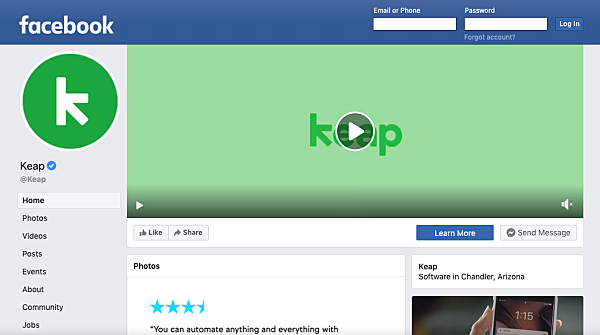As part of this report, we solicited insight from key marketing leaders and small business experts with a focus on the marketing trends they believe will impact small businesses in 2020 and what entrepreneurs and their marketers can do to maximize success. They delivered on a wide range of marketing topics…
Clate Mask’s small business customer predictions for 2020
Clate Mask has been educating and inspiring entrepreneurs for more than a decade. As CEO, Clate is leading Keap in its mission to simplify growth for millions of small businesses. He is a national speaker on entrepreneurship and co-author of the New York Times bestseller, Conquer the Chaos: How to Grow a Successful Small Business without Going Crazy. In a video produced exclusively to complement this report, Mask discusses, among other things, his keys for small business marketers in 2020:
I believe your best approach in 2020 is to strengthen the relationships with your existing customers, and I share that for a couple of reasons: Number one, there's an age-old truism that says the best profitable way to grow your business is by working with existing customers. And that's absolutely true. But there's a second reason why I say it for 2020 and that is that I believe that the combination of two significant trends require that business owners focus more on customers.
The first trend is a bull market that we've been in for a long time. That's not always going to play out, and so when bear markets come, those who have great customer relationships benefit and those who have not built great customer relationships suffer. I'm not predicting doom and gloom (in 2020), but I am noting the fact that we've been in a very strong economic market here in the U.S., and in many parts of the world, for quite some time. And so, the wise business owner would recognize that trend and make some adjustments around that. The second trend—when you think about the noise that is happening in the world more than ever—people want a connection and a personal relationship with the people they do business with. And the whole premise of being in small business versus being in a big business is that you can make it personal, you can create great connections … So that's a long way of saying what I would recommend you do is spend your time and money to build greater relationships with your customers.
Eric Goldschein’s small business finance predictions for 2020
Eric Goldschein is an editor and writer at Fundera, a marketplace for small business financial solutions. He covers entrepreneurship, small business trends, finance, and marketing.
Data Privacy: New privacy laws and changes in policy from tech giants such as Google and Facebook are changing the way that marketers target and engage prospective customers. Digital marketers, particularly in paid marketing, are having a harder time targeting based on specific data points, and instead are leaning heavier into automation and broad targeting to find their prospective customer. I think this is a good thing. Privacy is a hot-button issue that many of us are worried about personally—now those concerns must be heeded by the marketing community, forcing us to be smarter and more responsible in how we reach people.
Community-building: People don't like feeling like customers. When they are loyal to a brand, it's not because they love the feeling of being charged for a certain product, it's because they feel like they are a part of the tribe. That tribe could be the company itself, or the people like them who shop with the brand. Companies like Patagonia and Nike do a great job of this. Digital marketers likely know the tribe that makes up Traffic Think Tank as well.
One unique way that marketing teams can build communities in 2020 is through platforms like Facebook and even Slack. These semi-private communities (some you need to join by invitation or even by paying a fee) provide people with expert insights, innovative strategies, and, perhaps most of all, a sense of belonging within an industry or niche. You can also use these communities to promote exclusive events or promotions that customers and peers won't find anywhere else.
Thought leadership on LinkedIn: Over the last few years, LinkedIn has done a great job of building itself as a marketing channel, especially for B2B companies. It's truly the social platform for business leaders, thinkers, and decision makers. In 2020, I'd like to see leaders and marketers continue to use LinkedIn to build their brand (and by extension the brand of their business) with posts about their own experiences, growth, and stories of success and failure. This type of marketing is directed just as much toward prospective employees as customers. When you build a brand as an innovative, transparent, and passionate leader, others will follow.
Mari Smith’s Facebook predictions for 2020 (specific to expertise)
Mari Smith is the Premier Facebook Marketing Expert and is often referred to as “the Queen of Facebook.” Forbes magazine says, “Even Facebook asks for her help.” Facebook hired Mari over the years to teach businesses throughout the U.S. and help create its Blueprint certification programs. Mari is a top keynote speaker, corporate social media strategist and brand ambassador for numerous organizations. She is an expert webinar leader, dynamic live video host and author of The New Relationship Marketing.
Facebook and Instagram Stories format will continue to grow in popularity throughout 2020. So much so, that regular feed content will noticeably slow down. And, it's quite feasible that both Facebook and Instagram may start rolling out more robust tests of its blended News Feed + Stories format. Both platforms very briefly tested such a merged, horizontal interface and both were met with disdain.
However, most social media users balk at sudden, radical change so Facebook has to come up with a way to gradually phase in this merged feed on either or both platforms. One way has been to make the Stories "cards" bigger and bigger and more prominent on both the Facebook mobile app and desktop, and intersperse them throughout the regular News Feed.
Plus, Facebook keeps making it easier and more enticing for users to publish content to Stories, such as sharing daily memories and automatically publishing feed posts to Stories as well.
Marketers should understand why the Stories format is being pushed so heavily.
First, clear back in July 2016 on the Q2-2016 earnings call, Facebook CFO Dave Wehner declared that the company was running out of places in News Feed to show people ads. To help mitigate this max ad load, Facebook spun up ads on Instagram in 2018, but soon started maximizing ad load there, too.
This means that Facebook absolutely has to find new ways for ad placement. And those new ways include i) Stories, ii) video ad breaks, and iii) Messenger ads, among others.

Second, the future of Facebook's News Feed has been in question ever since CEO Mark Zuckerberg published his 3,200-word privacy manifesto, declaring that the company would be pivoting away from permanent public posts and toward private, encrypted messaging.
Consider how incredibly easy it is for users to consume content in the Stories format. Tap, swipe, tap, swipe. The user is in complete control. They can view as much or as little of any individual account's Stories as they wish. Also, creators can publish an abundance of Stories and not worry about 'jamming up' their followers' feeds. Plus, with the 24-hour shelf-life of a Story, creators have to keep producing content, which means more inventory for ad placement.
Inserting ads into Stories just makes sense and there's plenty of inventory. On Facebook's Q3-2019 earnings call on October 30, COO Sheryl Sandberg stated that of the more than 7 million advertisers across the Facebook family of apps, there are already 3 million advertising across Facebook, Instagram, and Messenger Stories. Much of this is likely due to Facebook’s automatic placements feature.
Publishing more organic Stories and creating native Stories ads is a great place to focus in 2020. One hot tip for you: be sure to include interactive elements in your Stories such as polls, quizzes, sliders, questions, and donations. Instagram allows the polls sticker in Story ads, too. People love to touch their phones. Some studies show that people touch their phones over 2,600 times a day. And extreme cellphone users (in the top 10%) touch their phones as much as 5,400 times daily. Amazing.
Given Facebook’s need to identify and create new placements for ads, marketers would do well to observe the following:
Additional features and improvements to Stories on both Facebook and Instagram, on both the organic and paid side.
New ad units and/or ad placement options that Facebook and Instagram roll out. These include ads in search results on Facebook and ads on Instagram Explore.
Creative ways to stand out with video. Video content will continue to grow across all social platforms. I declared 2013 as the Year of the Video. It seems that keeps being true every year since!
Facebook Messenger chatbots will also continue to grow in 2020 and beyond, so long as marketers adhere to best practices and abide by Facebook’s tight rules.
Given Mark Zuckerberg’s declaration in January 2019 to integrate his company’s three main messaging services (Messenger, WhatsApp and Instagram Direct) through a new interoperable infrastructure, we will definitely see developments in this area in 2020. Even if the FTC manages to prevent such a binding together of Facebook’s apps, Zuckerberg will forge ahead with all manner of growth around mobile commerce, transactions, and secure payments. Plus, 2020 could see both Instagram and WhatsApp opening up their respective API’s for marketing automation via chatbots.
At the end of the day, Zuckerberg has long envied China’s all-encompassing “SuperApp,” WeChat, which is like the entire internet in one platform. Facebook will never be able to compete at this level in terms of comprehensive services in one app; but the entire family of Facebook apps and services will certainly try.
As The New York Times states, “What is happening in China offers clues to not only how Facebook may carry out its shift, but how the internet more broadly might change.” And that is something us marketers would do well to keep a close eye on if you’re not already.”
Brian Solis’ digital marketing predictions for 2020
Brian Solis is a world-leading digital analyst in innovation, digital transformation and experience. He’s also an 8x best-selling author and keynote speaker on the future of business and markets. Follow his work online at BrianSolis.com, on Twitter and LinkedIn.
Search and content are more important than ever when it comes to small business. Mobile was a game changer. But many businesses have yet to catch up with how mobile changed customer behaviors. Almost every customer reaches for their device when they set out to make a decision. With mobile, their intent, expectations and behaviors change over that of the traditional web. Time becomes important. Intuitive, simple and fast touchpoints become the standard. Highly personalized and relevant experiences are becoming competitive differentiators. This means businesses must rethink the customer journey for mobile experiences. Ads, content, pages, next best actions, click paths, all need to be optimized for mobile customer expectations as they continually evolve.
Now voice is also becoming part of the experience. As more users connect with voice devices, all of the above is the same for connecting with Alexa, Google Home and Siri. New skills on Alexa, for example, are helping create vocal customer journeys that optimize for the nuances of more rapid, direct, descriptive and transactional touchpoints.
Visual and augmented reality (AR) too is starting to enable the visual customer journey. Apps such as Google Lens allow customers to search by looking at an object and as they do, expect a visual (and mobile-optimized) journey.
The future is about discoverability. You have to be present in ways that are relevant to customer moments, intentions and devices. That’s the context for engagement. From there, dedicated and personalized experiences, how you talk, what you show, what you say, become the differentiation that sets you apart. But if you don’t show up the right way, at the right time, on the right device, then you’re by default out of contention in the customer journey. As the old saying goes, out of sight, out of mind. Perhaps it should be updated. Without discoverability, whether that’s text, voice or visual, there can be no consideration.
Meredith Wood's automation and content predictions for 2020
Meredith Wood is the founding editor of the Fundera Ledger and a vice president at Fundera. She launched the Fundera Ledger in 2014 and has specialized in financial advice for small business owners for almost a decade. Meredith is frequently sought out for her expertise in small business lending. She is a monthly columnist for AllBusiness, and her advice has appeared in the SBA, SCORE, Yahoo, Amex OPEN Forum, Fox Business, American Banker, Small Business Trends, MyCorporation, Small Biz Daily, StartupNation, and more.
Customer journey: From acquisition to well after the first transaction, businesses are investing in relationship-building assets and processes that will allow them to re-engage with customers over longer periods of time, in order to build loyalty and increase retention. Through marketing automation, business owners will continue to use social media targeting and email marketing to stay in front of customers. They’ll also make use of customer-centric tactics, such as follow-up surveys and real-time contact with CX representatives to preserve and nurture their relationship with customers.
Data visualization and storytelling: Marketing performance data needs to be tracked, consolidated, and organized so business owners can understand the impact of their various tools and channels, while also scaling reach to new and prospective customers. This trend goes hand-in-hand with the importance of brand storytelling and using data to create compelling narratives that businesses can share.
Impressive long-form content: Business owners will invest more in long-form content that impresses readers and stands out among all of the content that exists today. They will go above and beyond to offer more value to customers by giving them highly in-depth, well-researched, quality content- which means jazzier e-books, bigger case studies, interactive webinars, and more. By doing this, businesses will carve their brand voice out from competitors and make a larger and continuous impact on audiences. Truly impressive long-form content will deliver meaningful value far after it’s published, and return on this type of content marketing strategy can include: increased traffic, increased time on site, more social media engagement, and brand building.
Dennis Yu’s small business video predictions for 2020
Dennis Yu is the chief technology officer at BlitzMetrics, a digital marketing company. Dennis has been featured in The Wall Street Journal, New York Times, LA Times, TechCrunch, Fox News, and is the co-author of Facebook Nation. He regularly contributes to Adweek’s SocialTimes, and has published in Social Media Examiner, Social Media Club, and Social Fresh.
I was just at Facebook HQ this morning and want to share with you this marketing trend you cannot ignore in 2020:
Authentic-looking, short-form, distributed video is now key to driving sales for small business.
AUTHENTIC-LOOKING means it doesn't look like an advertisement. So consider:
Using your cell phone to document a day in the life of your business, your customers, and your people. No need to hire a fancy videographer, since you're here to drive sales, not win awards on a feature film. Welton Hong serves funeral homes and brings his customers along for the ride, like a good friend, not a salesperson. Potential customers tell him that they feel like they know him, even though they've never met.
Film vertically (not horizontally), since 85% of your customers' attention is on mobile, not desktop. And that includes email, where 80% of emails are opened on a cell phone. Travis Chambers whips out his phone to share what's on his mind. The irony is by sharing his struggles, instead of his successes, this year, he was able to land 30 clients each paying him $100,000 per project.
Authentic-looking means do the exact opposite of what looks like an ad. People are too smart for ads, wouldn't you agree? This is great news for us small business owners, since one-minute videos cost us nothing to produce, require little outside help, and literally take one minute. The opposite of an ad means:
Have your customer speak for you (not you talking about you).
- Rarely use a call-to-action (90% of the time, drive conversation, not conversion).
- Have imperfection in your marketing (too shiny is clearly a commercial).
- Share personal stories via video (not stock art images from a marketing consultant).
SHORT-FORM means snippets are 15 seconds, 60 seconds, and even 5 minutes long--long enough to tell a story.
Organize your content strategy by six themes (or topics). Dr. Karen Sutherland posts hundreds of sunset pictures on her Instagram. She has consistently built her brand around this theme, snapping sunsets from all over the world. Her community loves these moments, so when she puts her sunset calendar on sale each December, people flock to buy them months ahead of time. Note that her posts are purely inspirational year-round, minus a couple of promotional posts at the end of the year. She is not constantly promoting her products.
Stories, by definition, contain emotion--meaning that they must be personal. Facebook, Google, YouTube, LinkedIn, and all major digital platforms throttle reach based on engagement levels, which are, in turn, based on emotional payload. Justen Marin is a Denver mortgage broker who shares how he's managed his business while dealing with his wife's breast cancer treatments. Humanizing his business attracts more customers, since people want to work with people.
Podcasts and interviews are an excellent way for you to generate 100 short-form pieces of content in just one hour. Jeremy Slate, CEO of Command Your Brand Media, interviews business leaders on how they overcame challenges. His team cuts one-hour interviews into 60-second sound bytes for Facebook, quote cards on Twitter, transcribed blog posts, and compilations that go across any network.
DISTRIBUTED means that you post the same content across multiple channels, usually with little modification, if any. The purists will say that you should create channel-specific content. And if you have that sort of time and budget, go for it. Practically speaking, the algorithms that power the networks are looking for signal strength and diversity--social proof plus reinforcement of that signal in many areas. Thus:
Boost posts on Facebook for $1 a day via this framework. When there's more engagement, driven by paid or not, the algorithm sees that as a vote for more newsfeed distribution. When you think about it, this isn't cheating, since this is still real humans engaging with?your content. And Facebook wants to share that with friends of that user, which enhances the word-of-mouth effect for you.
Take what's working on one channel and cross-post it to another. You could push your LinkedIn content to your site, your Facebook posts to Twitter, email content to Quora, and so forth. Brian Solis wrote a great blog post about the Peloton ad controversy. But since only some of his audience is on Google or his websites, he shared it to Facebook and other channels, too. Meet your community where they are.
Hire out community management--to cross-post, collect positive feedback, and curate your content. You could hire a virtual assistant for $450 full-time per month on onlinejobs.ph, dedicated to your personal and company brand. Or enlist a young adult for a great entry-level job (your son or someone from the local college). Or even spend $15-50 a month to hire a freelancer on Fiverr for community management. Brennan Agranoff, the 19-year-old who is selling $2 million of socks online each year, has 60 virtual assistants from the Philippines. This army works full-time to identify influencers, send out free socks, collect testimonials, build ads, and run support--all the functions that we're talking about here. And he's paying less than $2/hour for them.
In 2020, you'll need a content machine to be able to do all this—you can't do it all by yourself. Even with Keap for marketing automation, you still need humans and a process to run the machines. But the good news is that you don't have to have ALL of these components. You only need to be more advanced than your closest competitor!
Most of your competitors are still brute-forcing advertisements into digital, instead of embracing authentic-looking, short-form, distributed content.
Colin Wayne, CEO of Redline Steel, started his home decor company just three years ago and is now the biggest player in his industry in the United States. How did he beat the big boys as a brand new player?
He fosters a close connection by going live almost daily. When I was at his warehouse in Huntsville, Ala., last week, he went live on Facebook to showcase and get feedback on three new designs that nobody has seen. Watch the specific techniques he used (as we've discussed here) to get 10,000 comments on that live video with zero ads.
Scientists studied the differences in communication patterns between couples in a new relationship versus happily married for years. They found that strong relationships were evidenced by frequent, lightweight touches—one-word answers and short phrases. It could be "milk?" with the partner responding "yes.”
Conversely, new couples would intentionally delay responses (to not seem desperate) and carefully craft long love letters. Consider in your marketing efforts whether you want to take advantage of patterns that reinforce strong relationships with your customers or make it look like you're constantly being a suitor.
Try free
14-day free trial. No credit card required.










